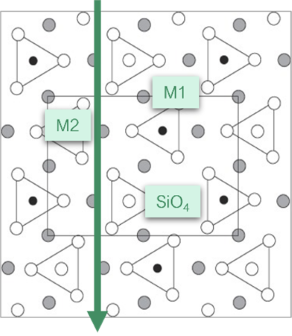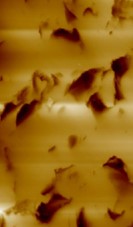Overview
Olivine ([Mg, Fe]2SiO4) is a promising material for Carbon Capture and Storage (CCS) technologies, as it naturally undergoes chemical weathering – the process in which minerals dissolve when exposed to chemicals in nature. During weathering, olivine acts source of cations that can react with CO2 in water to form stable minerals in a dissolution-reprecipitation reaction, but the specifics of the process are still unclear [1]. Olivine dissolution proceeds in a preferential direction, possibly due to its crystal structure. Metallic cations occupy two different types of sites in the lattice, M1 and M2. Cations in the M2 lattice site are more loosely bound, and therefore, during dissolution, are more easily released into solution. Understanding the microscopic properties of olivine dissolution is an important step to improve artificial weathering. Atomic Force Microscopy is a powerful tool to image the changes in surface morphology during dissolution and can be used to characterize the process by quantifying the dissolution rate [2] and understanding its connection with the crystal structure of olivine.



(a) (b) (c)
(a) Olivine crystal structure. AFM images of olivine surface when (b) pristine and (c) weathered. The arrows show the theoretical (a) and observed (c) preferential direction of dissolution.
Research Objective
The goal of this Bachelor assignment is to contribute to the understanding of olivine dissolution by analyzing the changes in surface morphology and quantifying the dissolution rate using Atomic Force Microscopy.
Learning Objective
In addition to the standard learning objectives for a bachelor’s project, you will:
· Learn about Atomic Force Microscopy imaging, measurement and data analysis.
· Learn about mineral carbonation techniques, dissolution-reprecipitation reactions and relevant applications in CO2 capture.
· Have basic chemical-lab training (preparing solutions and surfaces, etc.)
Contact Information
· Daily Supervision: Vincenzo Alagia
· Supervision: Igor Siretanu
Literature
[1]: E.H. Oelkers et al., Chemical Geology 2018 (recent review on olivine)
[2]: X. Li et al., Applied Surface Science 2021 (AFM to analyse olivine dissolution)
